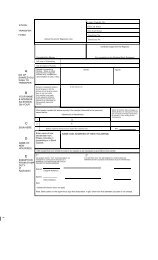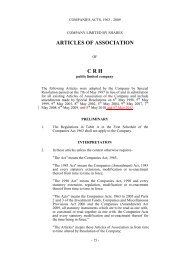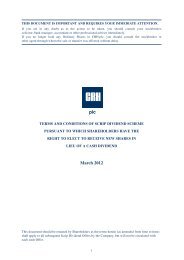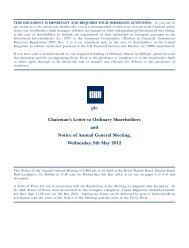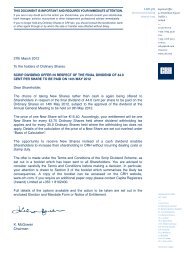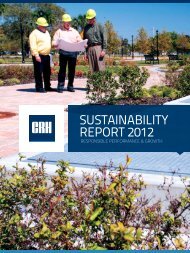2009 Annual Report - CRH
2009 Annual Report - CRH
2009 Annual Report - CRH
- TAGS
- annual
- www.crh.com
You also want an ePaper? Increase the reach of your titles
YUMPU automatically turns print PDFs into web optimized ePapers that Google loves.
21. Capital and Financial Risk Management<br />
Capital management<br />
Overall summary<br />
The primary objectives of <strong>CRH</strong>’s capital management strategy are to ensure that the Group maintains a strong credit rating to support its business and to create<br />
shareholder value by managing the debt and equity balance and the cost of capital.<br />
The Board periodically reviews the capital structure of the Group, including the cost of capital and the risks associated with each class of capital. The Group manages<br />
and, if necessary, adjusts its capital structure taking account of underlying economic conditions; any material adjustments to the Group’s capital structure in terms of<br />
the relative proportions of debt and equity are approved by the Board. In order to maintain or adjust the capital structure, the Group may issue new shares, dispose<br />
of assets, amend investment plans, alter dividend policy or return capital to shareholders. The Group is committed to optimising the use of its balance sheet within<br />
the confines of the overall objective to maintain an investment grade credit rating. Dividend cover for the year ended 31st December <strong>2009</strong> amounted to 1.4 times<br />
(2008: 3.4 times).<br />
The capital structure of the Group, which comprises net debt and capital and reserves attributable to the Company’s equity holders, may be summarised as follows:<br />
<strong>2009</strong> 2008<br />
€m €m<br />
Capital and reserves attributable to the Company's equity holders 9,637 8,087<br />
Net debt (note 25) 3,723 6,091<br />
Capital and net debt 13,360 14,178<br />
Financial risk management objectives and policies<br />
The Group uses financial instruments throughout its businesses: interest-bearing loans and borrowings, cash and cash equivalents, short-dated liquid investments<br />
and finance leases are used to finance the Group’s operations; trade receivables and trade payables arise directly from operations; and derivatives, principally interest<br />
rate and currency swaps and forward foreign exchange contracts, are used to manage interest rate risks and currency exposures and to achieve the desired profile<br />
of borrowings. The Group does not trade in financial instruments nor does it enter into any leveraged derivative transactions.<br />
The Group’s corporate treasury function provides services to the business units, co-ordinates access to domestic and international financial markets, and monitors<br />
and manages the financial risks relating to the operations of the Group. The Group Treasurer reports to the Finance Director and the activities of the corporate treasury<br />
function are subject to regular internal audit. Systems are in place to monitor and control the Group’s liquidity risks. The Group’s net debt position forms part of the<br />
monthly documentation presented to the Board of Directors.<br />
The main risks attaching to the Group’s financial instruments are interest rate risk, foreign currency risk, credit risk and liquidity risk. Commodity price risk is of minimal<br />
relevance given that exposure is confined to a small number of contracts entered into for the purpose of hedging future movements in energy costs. The Board reviews<br />
and agrees policies for the prudent management of each of these risks as documented below.<br />
Interest rate risk<br />
The Group’s exposure to market risk for changes in interest rates stems predominantly from its long-term debt obligations. Interest cost is managed by the Group’s<br />
corporate treasury function using a mix of fixed and floating rate debt. With the objective of managing this mix in a cost-efficient manner, the Group enters into interest<br />
rate swaps, under which the Group contracts to exchange, at predetermined intervals, the difference between fixed and variable interest amounts calculated by<br />
reference to a pre-agreed notional principal. Such contracts enable the Group to mitigate the risk of changing interest rates on the fair value of issued fixed rate debt<br />
and the cash flow exposures of issued floating rate debt.<br />
The majority of these swaps are designated under IAS 39 to hedge underlying debt obligations and qualify for hedge accounting; undesignated financial instruments<br />
are termed “not designated as hedges” in the analysis of derivative financial instruments presented in note 24. The following table demonstrates the impact on profit<br />
before tax of a range of possible changes in the interest rates applicable to net floating rate borrowings, with all other variables held constant:<br />
Percentage change in cost of borrowings +/- 1% +/- 0.5%<br />
Impact on profit before tax <strong>2009</strong> -/+ €8m -/+ €4m<br />
2008 -/+ €32m -/+ €16m<br />
<strong>CRH</strong> 91








